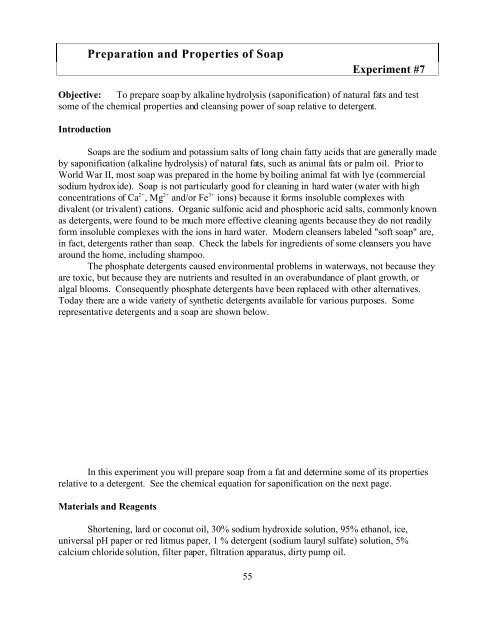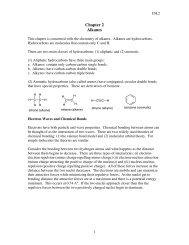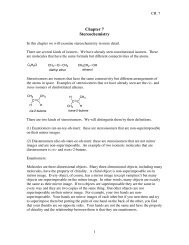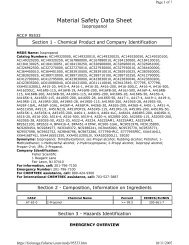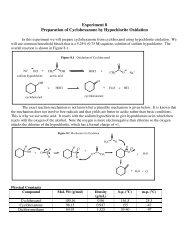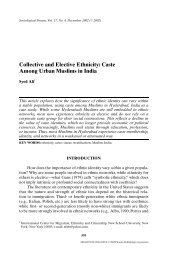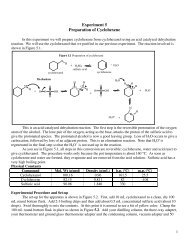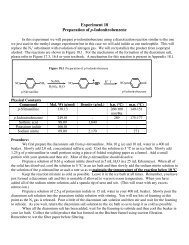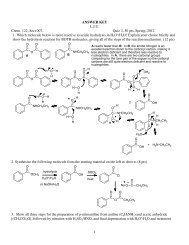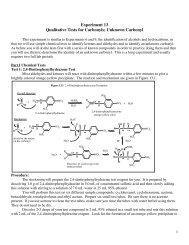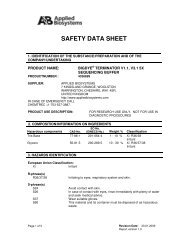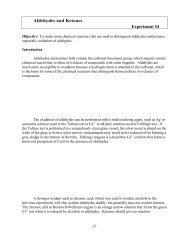Preparation and Properties of Soap - myweb
Preparation and Properties of Soap - myweb
Preparation and Properties of Soap - myweb
Create successful ePaper yourself
Turn your PDF publications into a flip-book with our unique Google optimized e-Paper software.
<strong>Preparation</strong> <strong>and</strong> <strong>Properties</strong> <strong>of</strong> <strong>Soap</strong><br />
Experiment #7<br />
Objective: To prepare soap by alkaline hydrolysis (saponification) <strong>of</strong> natural fats <strong>and</strong> test<br />
some <strong>of</strong> the chemical properties <strong>and</strong> cleansing power <strong>of</strong> soap relative to detergent.<br />
Introduction<br />
<strong>Soap</strong>s are the sodium <strong>and</strong> potassium salts <strong>of</strong> long chain fatty acids that are generally made<br />
by saponification (alkaline hydrolysis) <strong>of</strong> natural fats, such as animal fats or palm oil. Prior to<br />
World War II, most soap was prepared in the home by boiling animal fat with lye (commercial<br />
sodium hydroxide). <strong>Soap</strong> is not particularly good for cleaning in hard water (water with high<br />
concentrations <strong>of</strong> Ca 2+ , Mg 2+ <strong>and</strong>/or Fe 3+ ions) because it forms insoluble complexes with<br />
divalent (or trivalent) cations. Organic sulfonic acid <strong>and</strong> phosphoric acid salts, commonly known<br />
as detergents, were found to be much more effective cleaning agents because they do not readily<br />
form insoluble complexes with the ions in hard water. Modern cleansers labeled "s<strong>of</strong>t soap" are,<br />
in fact, detergents rather than soap. Check the labels for ingredients <strong>of</strong> some cleansers you have<br />
around the home, including shampoo.<br />
The phosphate detergents caused environmental problems in waterways, not because they<br />
are toxic, but because they are nutrients <strong>and</strong> resulted in an overabundance <strong>of</strong> plant growth, or<br />
algal blooms. Consequently phosphate detergents have been replaced with other alternatives.<br />
Today there are a wide variety <strong>of</strong> synthetic detergents available for various purposes. Some<br />
representative detergents <strong>and</strong> a soap are shown below.<br />
In this experiment you will prepare soap from a fat <strong>and</strong> determine some <strong>of</strong> its properties<br />
relative to a detergent. See the chemical equation for saponification on the next page.<br />
Materials <strong>and</strong> Reagents<br />
Shortening, lard or coconut oil, 30% sodium hydroxide solution, 95% ethanol, ice,<br />
universal pH paper or red litmus paper, 1 % detergent (sodium lauryl sulfate) solution, 5%<br />
calcium chloride solution, filter paper, filtration apparatus, dirty pump oil.<br />
55
Procedure<br />
Part A. <strong>Preparation</strong> <strong>of</strong> <strong>Soap</strong>.<br />
1. Add about 150 mL water to a 400 mL beaker <strong>and</strong> heat the water on a hot plate to about<br />
85°C. You will need to mount a clamp above the beaker to hold the Erlenmeyer flask<br />
upright in the water bath (see below).<br />
2. Add about 2 g (approx. a level, not heaping teaspoon) <strong>of</strong> shortening, coconut oil, or lard<br />
to a small beaker <strong>and</strong> dissolve it in 25 mL <strong>of</strong> 95% ethanol. Do not use too much fat or<br />
you will need more ethanol to dissolve it. Warm the ethanol <strong>and</strong> fat on the hotplate to get<br />
the fat to dissolve more easily. Do not allow the ethanol to boil.<br />
CAUTION!! SODIUM HYDROXIDE SOLUTION IS VERY CAUSTIC. AVOID<br />
GETTING IT ON YOUR SKIN OR CLOTHING. WASH IT OFF IMMEDIATELY<br />
WITH PLENTY OF WATER.<br />
3. When the fat is completely dissolved,<br />
pour the solution into a 125 mL<br />
Erlenmeyer flask <strong>and</strong> add 10 mL <strong>of</strong> 30%<br />
NaOH solution. Swirl the flask to mix<br />
the solution <strong>and</strong> add a few (3 to 5) boiling<br />
chips (Boilezers) to the flask.<br />
4. Place the flask containing the fat solution<br />
in the water bath <strong>and</strong> fasten it with a<br />
clamp to hold it upright in the water bath.<br />
Place a small watch glass over the mouth<br />
<strong>of</strong> the flask to minimize evaporation <strong>of</strong><br />
the alcohol. Place an ice cube in the<br />
watch glass to more effectively condense<br />
the alcohol.<br />
5. Allow the the fat-alcoholic NaOH solution to boil for at least 30 min. [Note: do not boil<br />
the water in the water bath]. If you observe undissolved fat in the flask, add a little<br />
more ethanol to the flask <strong>and</strong> stir to dissolve the fat. Do not allow the hot water bath to<br />
56
get too hot, keep it just hot enough to have controlled boiling <strong>of</strong> the fat solution.<br />
6. While the saponification proceeds, prepare a salt solution by completely dissolving 20 g<br />
NaCl in 100 mL deionized water in a 250 mL beaker. After the salt completely dissolves,<br />
transfer about half <strong>of</strong> this salt solution to another beaker <strong>and</strong> place both beakers <strong>of</strong> salt<br />
solution on ice to cool them.<br />
7. After 30 min, test the fat solution to see if saponification is complete by placing a few<br />
drops <strong>of</strong> the solution in a test tube <strong>of</strong> deionized water. If you see fat droplets float to the<br />
top, the saponification is not complete <strong>and</strong> allow it to boil for an additional 10 min.<br />
8. When saponification is complete, carefully pour the hot reaction mixture into one beaker<br />
<strong>of</strong> salt solution <strong>and</strong> stir for a minute or two. Place the mixture on ice to cool it before<br />
filtering.<br />
9. Set up a suction filtration apparatus with a Buchner funnel <strong>and</strong> filter paper (see Appendix<br />
I for a diagram <strong>of</strong> the vacuum filtration apparatus). Filter the mixture from step 8, <strong>and</strong><br />
wash the soap (remaining in the Buchner funnel) twice with ice cold salt water (from the<br />
second beaker). Draw air through the soap for a few minutes to remove most <strong>of</strong> the<br />
water.<br />
10. Remove the soap cake from the Buchner funnel <strong>and</strong> save it for the following tests.<br />
Part B. Comparison <strong>of</strong> the <strong>Properties</strong> <strong>of</strong> <strong>Soap</strong> with Detergent.<br />
B-1. Alkalinity<br />
1. Prepare a 1% soap solution by dissolving about 0.5 g <strong>of</strong> the soap you just made in 50 mL<br />
<strong>of</strong> deionized water. It may help to heat the water to get the soap to dissolve completely.<br />
2. Use a glass stirring rod to place a drop <strong>of</strong> the soap solution on a piece <strong>of</strong> universal pH<br />
paper to determine whether the solution is alkaline, neutral or acid. Record your<br />
observation on the Report Sheet.<br />
3. Add about 5 mL <strong>of</strong> detergent (e.g., sodium laurylsulfate) solution to a beaker or test tube.<br />
You will compare this solution with your soap solution for the remaining tests.<br />
4. Test the detergent solution to see if it is alkaline, neutral or acidic by placing one drop <strong>of</strong><br />
the detergent solution on a strip <strong>of</strong> pH paper or red litmus paper. Record your<br />
observation on the Report Sheet.<br />
B-2. Lathering Power<br />
1. Add about 2 mL <strong>of</strong> deionized water to four large test tubes.<br />
57
2. Add an equal amount <strong>of</strong> soap solution to one test tube <strong>of</strong> water <strong>and</strong> shake vigorously by<br />
placing a stopper in the tube. This should give a permanent lather that lasts for at least 30<br />
sec. If the lather doesn't last, add another 10 drops <strong>of</strong> soap solution <strong>and</strong> shake vigorously.<br />
3. Add an equal amount <strong>of</strong> detergent solution to another test tube <strong>of</strong> water <strong>and</strong> shake<br />
vigorously. This should give a permanent lather. If not, add another 10 drops <strong>and</strong> shake<br />
vigorously. Record the results on the report sheet.<br />
4. Add 2 mL <strong>of</strong> 5% calcium chloride solution to each <strong>of</strong> the two remaining test tubes <strong>of</strong><br />
water.<br />
5. Add an equal amount <strong>of</strong> soap solution to one <strong>of</strong> the tubes containing calcium ion <strong>and</strong><br />
shake vigorously. Notice whether this solution forms a permanent lather <strong>and</strong> note<br />
whether there is any floculent precipitate in the tube. Does the precipitate float or sink?<br />
6. Add an equal amount <strong>of</strong> detergent solution to the other tube containing Ca 2+ ion <strong>and</strong><br />
shake vigorously to get a permanent lather. Does the lathering power <strong>of</strong> the detergent<br />
differ from the soap when Ca 2+ is present? Is there any precipitate in this solution?<br />
Record the results on the report sheet.<br />
B-3. Cleansing Power<br />
1. Place a drop <strong>of</strong> used oil or fat, such as shortening, on four separate thin strips <strong>of</strong> filter<br />
paper. Make sure the strips <strong>of</strong> filter paper will fit in the test tubes used in part B-2.<br />
2. Place one filter paper with oil spot in the tube containing soap in water. Place another in<br />
the tube containing detergent <strong>and</strong> water. Place a third strip in the tube containing soap in<br />
calcium solution. Place the fourth strip <strong>of</strong> oily paper in the tube containing detergent <strong>and</strong><br />
calcium solution. Shake each one well <strong>and</strong> make sure the filter paper is immersed in the<br />
solution.<br />
3. After 2 min remove the filter paper <strong>and</strong> rinse with tap water. Did the oil get washed out<br />
<strong>of</strong> the filter paper strip? You can discard the solutions in the sink. Throw the paper strips<br />
in the trash can. Compare the cleaning power <strong>of</strong> soap vs detergent on the Report Sheet.<br />
58
Name ________________________________________<br />
<strong>Preparation</strong> <strong>and</strong> <strong>Properties</strong> <strong>of</strong> <strong>Soap</strong><br />
Experiment #7<br />
Section ______________<br />
Pre-Lab Exercise<br />
1. What is the chemical nature <strong>of</strong> fats <strong>and</strong> oils, i.e., what class <strong>of</strong> chemical compounds make up the<br />
bulk <strong>of</strong> fats <strong>and</strong> oils? Are they alcohols, aldehydes, ketones, acids, esters, or amines?<br />
2. Describe the chemical reaction that takes place in the process <strong>of</strong> saponification. What are the<br />
reactants? What are the products? Show a representative chemical reaction for saponification.<br />
3. How do soaps differ from detergents? (See text book or check the internet)<br />
59
4. Briefly describe how soap <strong>and</strong> detergent work to clean your body or to clean other surfaces, such<br />
as dishes. Why are these agents (soap or detergent) needed in order to have thorough cleaning?<br />
60
Name ________________________________<br />
<strong>Preparation</strong> <strong>and</strong> <strong>Properties</strong> <strong>of</strong> <strong>Soap</strong><br />
Experiment #7<br />
Section ________<br />
Data & Report Sheet<br />
A-1.<br />
with.<br />
Describe the look <strong>and</strong> feel <strong>of</strong> the soap you have made, compared to the fat you started<br />
A-2.<br />
How does your soap compare with the look <strong>and</strong> feel <strong>of</strong> commercial soap?<br />
Table B1. Comparison <strong>of</strong> <strong>Properties</strong> <strong>of</strong> <strong>Soap</strong> vs Detergent<br />
Alkalinity test with<br />
pH indicator paper<br />
Color <strong>of</strong><br />
test paper<br />
Is it alkaline,<br />
neutral or acid<br />
no calcium<br />
Lathering <strong>and</strong><br />
solubility<br />
with calcium<br />
<strong>Soap</strong><br />
Detergent<br />
B-1. What conclusion would you make with regard to the harshness <strong>of</strong> soap vs detergent on<br />
skin from the alkalinity test?<br />
61
B-2. Compare the lathering power <strong>and</strong> solubility <strong>of</strong> soap vs detergent in hard water (calcium<br />
solution).<br />
B-3. Would you expect soap or detergent to be a more effective cleanser (dissolving oils) in hard<br />
water (water with high level <strong>of</strong> calcium or magnesium ions)? Explain.<br />
B-4. Describe the oil spot on the filter paper after cleansing with soap vs detergent in water. Is<br />
there a noticeable difference? Which is the more effective cleanser in deionized water?<br />
B-5. Describe any differences in the cleaning power <strong>of</strong> soap vs detergent in calcium solution.<br />
62


